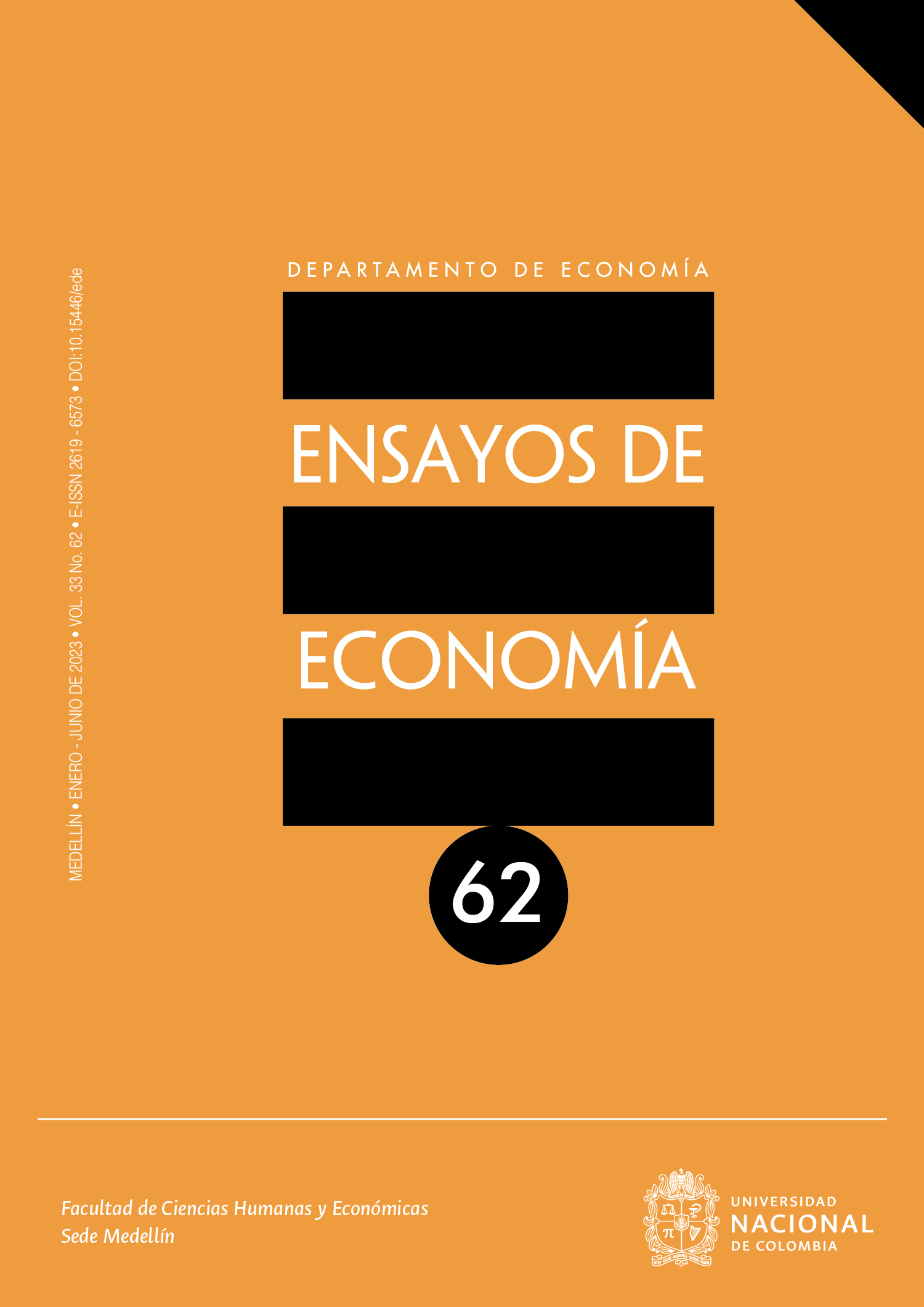Is the economy a complex system in eternal disequilibrium?
¿Es la economía un sistema complejo en eterno desequilibrio?
DOI:
https://doi.org/10.15446/ede.v33n62.99454Palabras clave:
real world economics, disequilibrium, collective decision making (en)Economía del mundo real, desequilibrio, toma colectiva de decisiones (es)
Descargas
This article presents a general discussion of some of the reasons for believing that an economy would be better framed in the theory of complex (organic) systems than in the theory of mechanical systems of the dominant neoclassical school. Complex systems are characterized here by heterogeneous units that interact with each other, with non-linear trajectories, positive feedbacks, co-creation of regularities, non-ergodicity of the system and constant evolution. Financial and urban systems are analyzed as examples of economic problems that present these characteristics.
Este artículo presenta una discusión general sobre algunas de las razones que se tienen para creer que una economía estaría mejor enmarcada en la teoría de los sistemas complejos (orgánicos) que en la teoría de los sistemas mecánicos de la escuela neoclásica dominante. Los sistemas complejos se caracterizan aquí por unidades heterogéneas que interactúan entre ellas, con trayectorias no-lineales, retroalimentaciones positivas, co-creación de regularidades, no-ergodicidad del sistema y constante evolución. De manera particular, se analizan los sistemas financieros y urbanos como ejemplos de problemas económicos que presentan estas características.
Referencias
Arrow, K., & Hahn, F. (1971). General Competitive Analysis. Holden-Day.
Arthur, W. (1994). Inductive Reasoning and Bounded Rationality. The American Economic Review, 84(2), 406-411. https://www.jstor.org/stable/2117868
Arthur, W. (2009). The Nature of Technology: What It Is and How It Evolves. Free Press.
Arthur, W., Beinhocker, E., & Stanger, A. (2020). Complexity Economics: Dialogues of the Applied Complexity Network. Proceedings of the Santa Fe Institute’s 2019 Fall Symposium. SFI Press. Santa Fe Institute.
Ávila, D. (2022). Spin-glass y la Mano Invisible de Adam Smith [master's degree thesis, Universidad Nacional de Colombia - Sede Bogotá]. https://repositorio.unal.edu.co/handle/unal/82914
Bak, P., & Chen, K. (1991). Self-Organized Criticality. Scientific American, 264(1), 46–53. http://www.jstor.org/stable/24936753
Banerjee, A., Burlina, P., & Alajaji, F. (1999). Image Segmentation and Labeling Using The Polya Urn Model. IEEE Transactions on Image Processing, 8(9), 1243–1253. https://doi.org/10.1109/83.784436
Barabási, A., Albert, R., & Jeong, H. (1999). Mean-Field Theory for Scale-Free Random Networks. Physica A: Statistical Mechanics and Its Applications, 272(1–2), 173–187. https://doi.org/10.1016/S0378-4371(99)00291-5
Bassett, D., & Claveau, F. (2018). El entomólogo económico: entrevista con Alan Kirman. Revista de Economía Institucional, 21(40), 343–366. https://doi.org/10.18601/01245996.v21n40.13
Benhabib, J., Bisin, A., & Zhu, S. (2011). The Distribution of Wealth and Fiscal Policy in Economies with Finitely Lived Agents. Econometrica, 79(1), 123–157. https://doi.org/10.3982/ECTA8416
Bettencourt, L. (2013a). The Origins of Scaling In Cities. Science, 340(6139), 1438–1441. https://doi.org/10.1126/science.1235823
Bettencourt, L. (2013b). Complexity, Cities and Energy. International Seminar on Nuclear War and Planetary Emergencies — 45th Session, 313–325. https://doi.org/10.1142/9789814531788_0027
Bettencourt, L., & Lobo, J. (2019). Quantitative Methods for The Comparative Analysis of Cities in History. Frontiers in Digital Humanities, 6. https://doi.org/10.3389/fdigh.2019.00017
Bikhchandani, S., & Sharma, S. (2001). Herd Behavior in Financial Markets. IMF Staff Papers, 47(3), 279–310. https://www.imf.org/External/Pubs/FT/staffp/2001/01/pdf/Bikhchan.pdf
Birkhoff, G. (1917). Dynamical Systems with Two Degrees of Freedom. Transactions of the American Mathematical Society, 18(2), 199–300. https://doi.org/10.2307/1988861
Birkhoff, G. (1931). Proof of The Ergodic Theorem. Proceedings of the National Academy of Sciences, 17(12). https://doi.org/10.1073/pnas.17.2.656
Brown, J., Gillooly, J., Allen, A., Savage, V., & West, G. (2004). Toward a Metabolic Theory of Ecology. Ecology, 85(7), 1771–1789. https://doi.org/10.1890/03-9000
Brown, J., West, G., & Enquist, B. (2005). Yes, West, Brown and Enquist’s Model of Allometric Scaling is Both Mathematically Correct and Biologically Relevant. Functional Ecology, 19(4), 735–738. https://doi.org/10.1111/j.1365-2435.2005.01022.x
Capra, F., & Luisi, P. (2014). The Systems View of Life. Cambridge University Press. https://doi.org/10.1017/CBO9780511895555
Cara, M., Pla, O., & Guinea, F. (2000). Learning, Competition and Cooperation in Simple Games. The European Physical Journal B - Condensed Matter and Complex Systems, 13(3), 413–416. https://doi.org/10.1007/s100510050051
Challet, D., & Zhang, Y. (1997). Emergence of Cooperation and Organization in An Evolutionary Game. Physica A: Statistical Mechanics and Its Applications, 246(3–4), 407–418. https://doi.org/10.1016/S0378-4371(97)00419-6
Colander, D., & Kupers, R. (2014). Complexity and The Art of Public Policy Solving society’s problems from the bottom up. Princeton University Press.
Darwin, C. (1859). On the Origin of Species By Means of Natural Selection, or The Preservation of Favoured Races in The Struggle for Life. John Murray.
David, P. (1985). Clio and The Economics of QWERTY. The American Economic Review, 75(2), 332–337.
de Groot, A. (1965). Thought and Choice in Chess. Mouton.
Deichmann, U. (2017). Hierarchy, Determinism, and Specificity in Theories of Development and Evolution. History and Philosophy of the Life Sciences, 39(4), 33. https://doi.org/10.1007/s40656-017-0160-3
Dhami, S. (2016). The Foundations of Behavioral Economic Analysis. Oxford University Press.
Dvorak, A., Merrick, N., Dealey, W., & Ford, G. (1936). Typewriting Behavior: Psychology Applied to Teaching and Learning Typewriting. American Book Company.
Eggenberger, F., & Pólya, G. (1923). Über die statistik verketteter vorgänge. ZAMM - Zeitschrift Für Angewandte Mathematik Und Mechanik, 3(4), 279–289. https://doi.org/10.1002/zamm.19230030407
Faggini, M., & Parziale, A. (2012). The Failure of Economic Theory. Lessons from Chaos Theory. Modern Economy, 03(01), 1–10. https://doi.org/10.4236/me.2012.31001
Farmer, J., Way, R., & Mealy, P. (2020). Estimating the Costs of Energy Transition Scenarios Using Probabilistic Forecasting Methods. Institute for New Economic Thinking. https://www.inet.ox.ac.uk/files/energy_transition_cost_INET_working_paper_with_SI1.pdf
Fontana, M. (2010). The Santa Fe Perspective on Economics: Emerging Patterns in The Science of Complexity. History of Economic Ideas, 18(2), 167–196. https://www.jstor.org/stable/23723516
Gabaix, X. (1999). Zipf’s Law for Cities: An Explanation. The Quarterly Journal of Economics, 114(3), 739–767.
Gabaix, X. (2016). Power Laws in Economics: An Introduction. Journal of Economic Perspectives, 30(1), 185–206. https://doi.org/10.1257/jep.30.1.185
Gabaix, X., Gopikrishnan, P., Plerou, V., & Stanley, H. (2006). Institutional Investors and Stock Market Volatility. The Quarterly Journal of Economics, 121(2), 461–504. https://doi.org/10.1162/qjec.2006.121.2.461
Gabaix, X., & Ioannides, Y. (2004). The Evolution of City Size Distributions. Handbook of regional and urban economics, vol. 4, (pp. 2341–2378). Elsevier. https://doi.org/10.1016/S1574-0080(04)80010-5
Gabaix, X., & Maggiori, M. (2015). International Liquidity and exchange Rate Dynamics. The Quarterly Journal of Economics, 130(3), 1369–1420. https://doi.org/10.1093/qje/qjv016
Gibbs, J. (1902). Elementary Principles in Statistical Mechanics: Developed with Especial Reference to The Rational Foundation of Thermodynamics. C. Scribner’s Sons.
Gibrat, R. (1931). Les inégalités économiques. Recueil Sirey.
Gorman, W. (1961). On a Class of Preference Fields. Metroeconomica, 13(2), 53–56. https://doi.org/https://doi.org/10.1111/j.1467-999X.1961.tb00819.x
Heisenberg, W. (1927). Über den anschaulichen Inhalt der quantentheoretischen Kinematik und Mechanik. Zeitschrift Für Physik, 43(3–4), 172–198. https://doi.org/10.1007/BF01397280
Hicks, J. (1937). Mr. Keynes and the “Classics”; A Suggested Interpretation. Econometrica, 5(2), 147–159. https://doi.org/10.2307/1907242
Huang, W., & Day, R. (2001). On the Statistical Properties of Ergodic Economic Systems. Discrete Dynamics in Nature and Society, 6(3), 181–189. https://www.emis.de/journals/HOA/DDNS/Volume6_3/189.pdf
Jackson, M. (2019). The human network: how your social position determines your power, beliefs, and behaviors. Vintage.
Jackson, M., & Yariv, L. (2019). The Non-Existence of Representative Agents [working paper]. https://doi.org/10.2139/ssrn.2684776
Jhonson, N., & Kotz, S. (1977). Urn Models and Their Application. John Wiley & Sons.
Kaizoji, T. (2010). Multiple Equilibria and Chaos in A Discrete Tâtonnement Process. Journal of Economic Behavior & Organization, 76(3), 597–599. https://doi.org/10.1016/j.jebo.2010.09.008
Keynes, J. (1921). A treatise on probability (Vol. 31, Issue 2). Dover Publications.
Keynes, J. (1936). The General Theory of Employment Interest and Money. Macmillan and Co.
Kleiber, M. (1932). Body Size and Metabolism. Hilgardia, 6(11), 315–353. https://hilgardia.ucanr.edu/Abstract/?a=hilg.v06n11p315
Krugman, P. (1996). What Economists Can Learn from Evolutionary Theorists [speech]. European Association for Evolutionary Political Economy. http://www.mit.edu/~krugman/evolute.html
Kyle, A., & Obizhaeva, A. (2016). Market Microstructure Invariance: Empirical Hypotheses. Econometrica, 84(4), 1345–1404. https://doi.org/10.3982/ECTA10486
Lorenz, E. (1993). The Essence of Chaos. UCL.
Lucas, R. (1978). Asset Prices in An Exchange Economy. Econometrica, 46(6), 1429–1445. https://doi.org/10.2307/1913837
Lucas, R., & Moll, B. (2014). Knowledge Growth and The Allocation of Time. Journal of Political Economy, 122(1), 1–51. https://doi.org/10.1086/674363
Malthus, T. (1798). An Essay on the Principle of Population. McMaster University Archive for the History of Economic Thought.
Malthus, T. (1815). An Inquiry into The Nature and Progress of Rent, and The Principles by Which It Is Regulated. https://www.gutenberg.org/files/4336/4336-h/4336-h.htm
Marshall, A. (1890). Principles of Economics. Macmillan.
Marshall, A. (1919). Industry and trade. The Journal of Education, 89 (20), 544-545. https://doi.org/10.1177/002205741908902008
Marx, K. (1859). Zur Kritik der politischen Oekonomie. Henricus.
Mas-Colell, A., Whinston, M., & Green, J. (1995). Microeconomic Theory.Oxford University Press.
Menger, C., & Braumüller, W. (1871). Grundsätze der volkswirthschaftslehre.
Mitchell, M. (2009). Complexity: A Guided Tour. Oxford University Press.
Mitchell, M. (2019). Artificial Intelligence: A Guide for Thinking Humans. Penguin UK.
Monsalve, S., & Ávila, D. (n. d.). Microeconomia y Complejidad [working paper].
Muth, J. (1961). Rational Expectations and The Theory of Price Movements. Econometrica, 29(3), 315–335. https://doi.org/10.2307/1909635
Newman, M. (2005). Power laws, Pareto distributions and Zipf’s law. Contemporary Physics, 46(5), 323–351. https://doi.org/10.1080/00107510500052444
Palmer, R., Arthur, W., Holland, J., & LeBaron, B. (1999). An artificial stock market. Artificial Life and Robotics, 3(1), 27–31. https://doi.org/10.1007/BF02481484
Palmer, Richard, Arthur, W., Holland, J., LeBaron, B., & Tayler, P. (1994). Artificial economic life: a simple model of a stockmarket. Physica D: Nonlinear Phenomena, 75(1–3), 264–274. https://doi.org/10.1016/0167-2789(94)90287-9
Peters, O., & Gell-Mann, M. (2016). Evaluating Gambles Using Dynamics. Chaos: An Interdisciplinary Journal of Nonlinear Science, 26(2), 023103. https://doi.org/10.1063/1.4940236
Piketty, T., & Zucman, G. (2014). Capital Is Back: Wealth-Income Ratios in Rich Countries 1700–2010. The Quarterly Journal of Economics, 129(3), 1255–1310. https://doi.org/10.1093/qje/qju018
Poincaré, H. (1903). L’espace et ses trois dimensions. Revue de Métaphysique et de Morale, 11(3), 281–301. http://www.jstor.org/stable/40892786
Poitras, G. (2013). Ergodicity and the history of neoclassical economic theory [working paper]. https://www.sfu.ca/~poitras/HES_erg.pdf
Pólya, G. (1930). Sur quelques points de la théorie des probabilités. Annales de l’institut Henri Poincaré, 1(2), 117–161. www.numdam.org/item/AIHP_1930__1_2_117_0
Prigogine, I., & Stengers, I. (1997). The End of Certainty: Time’s Flow and The Laws of nature. Free Press.
Rodrik, D. (2015). Economic Rules : Why Economic Works, When It Fails, and How to Tell The Difference. Oxford University Press.
Saari, D. (1995). A Chaotic Exploration of Aggregation Paradoxes. SIAM Review, 37(1), 37–52. https://doi.org/10.1137/1037002
Samuelson, P. (1947). Foundations of Economic Analysis. Harvard University Press.
Sauce, B., & Matzel, L. (2017). Inductive reasoning. In J., Vonk, & T., Shackelford (eds) Encyclopedia of Animal Cognition and Behavior, 6 (1-8). Springer. https://doi.org/10.1007/978-3-319-47829-6_1045-1
Savage, L. (1954). The Foundations of Statistical Inference. John Wiley & Sons.
Savit, R., Manuca, R., & Riolo, R. (1997). Adaptive Competition, Market Efficiency, Phase Transitions and Spin-Glasses. http://arxiv.org/abs/adap-org/9712006
Savit, R., Manuca, R., & Riolo, R. (1999). Adaptive Competition, Market Efficiency, and Phase Transitions. Physical Review Letters, 82(10), 2203–2206. https://doi.org/10.1103/PhysRevLett.82.2203
Schumpeter, J. (1939). Business Cycles: A Theoretical, Historical and Statistical Analysis of The Capitalist Process (vol. 1). McGraw-Hill.
Sen, A., Paul, F., & Stiglitz, J. (2010). Mismeasuring our lives: Why GDP doesn’t add up. The New Press.
Shackle, G. (1938). Expectations, Investment and Income. Oxford University Press.
Smith, A. (1969). An inquiry into the nature and causes of the wealth of nations. W. Strachan and T. Cadell (original published on 1776).
Solé, R., & Elena, S. (2018). Viruses as complex adaptive systems. Princeton University Press.
Solomon, S., & Richmond, P. (2001). Power Laws of Wealth, Market Order Volumes and Market Returns. Physica A: Statistical Mechanics and Its Applications, 299(1–2), 188–197. https://doi.org/10.1016/S0378-4371(01)00295-3
Starr, R. M. (1997). General Equilibrium Theory : An Introduction. Cambridge University Press.
Swain, A., & Fagan, W. (2019). Group Size and decision Making: Experimental Evidence for Minority Games in Fish Behaviour. Animal Behaviour, 155, 9–19. https://doi.org/10.1016/j.anbehav.2019.05.017
Toda, A., & Walsh, K. (2015). The Double Power Law in Consumption and Implications for Testing Euler Equations. Journal of Political Economy, 123(5), 1177–1200. https://doi.org/10.1086/682729
Veblen, T. (1898). Why Is Economics Not an Evolutionary Science? The Quarterly Journal of Economics, 12(4), 373–397. https://doi.org/10.2307/1882952
Veblen, T. (1900). The Preconceptions of Economic Science. The Quarterly Journal of Economics, 14(2), 240–269. https://doi.org/10.2307/1883770
West, G. (2017). Scale: The Universal Laws of Life, Growth, and Death in Organisms, Cities, and Companies. Penguin Press.
West, G., Brown, J., & Enquist, B. (1997). A General Model for The Origin of Allometric Scaling Laws in Biology. Science, 276(5309), 122–126. https://doi.org/10.1126/science.276.5309.122
Cómo citar
APA
ACM
ACS
ABNT
Chicago
Harvard
IEEE
MLA
Turabian
Vancouver
Descargar cita
Licencia

Esta obra está bajo una licencia internacional Creative Commons Atribución-NoComercial-SinDerivadas 4.0.
Se autoriza la reproducción sin ánimo de lucro de los materiales, citando la fuente.



























